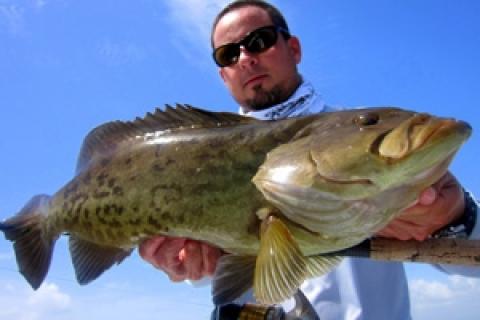
It's easy to take on a stereotypical mindset about the saltwater fishing, lifestyle and attractions in the Florida Keys, but the truth is that specific regions of the Keys offer different experiences. From a hydrogeological point of view the Florida Keys begin with Miami's Key Biscayne and "end" with the Marquesas. Even if you start with Key Largo, this vast swath encompasses everything from township coastlines to endless blue-green water and mangrove horizons and illustrates how much diversity this offers from an angler's point of view.
Card Sound is in the northern part of the upper Keys and is often overlooked by anglers headed deeper into the Keys towards Islamorada, Marathon and Key West. The "Sound" is also attached to extreme southern Biscayne Bay, a section that features less anglers than their brethren pursuing bonefish, tarpon, and permit a bit further to the north from Stiltsville to the Ragged Keys.
Captain Rob Munoz plies the waters of this less pressured area which offers a bounty of species on the flats that includes the "big three" (bonefish, tarpon and permit) of flats fishing plus other marine gamesters. This had long been an area I wanted to fish so Rob and I made a plan to meet in South Miami. From that pickup point, we'd drive together to Black Point Marina in southern Dade County where we'd be launching his eighteen-foot Hell's Bay Marquesa.
![]() TIP: Card Sound Florida Key History - LINK
TIP: Card Sound Florida Key History - LINK
After a quick launch and an idle out of the marina's channel, Rob turned his skiff south towards the open expanses of the western Biscayne Bay shoreline. In the soft glow of early morning, we were blessed with the slicked out waters that would enable us to see the tails and "pushes" of bonefish, permit, and perhaps even a Biscayne Bay redfish.

Card Sound Road
It wasn't long before Rob throttled back and turned off his engine. He mounted his poling tower and poled us the remaining one hundred yards to the mangrove shoreline. He mentioned that while we could hunt as far out as fifty yards from the shoreline we'd be missing the larger redfish attracted to shadows and protection of the foliage and roots. In our first hour we encountered one pod of tailing bonefish- which inexplicably passed over a perfectly cast live crab-, two pushes of unknown origin, and a huge but very spooky redfish that wound its' way through the mangrove roots and then eventually bolted for the open expanses of the bay.
At that point, the sun was high enough to see into the slightly deeper flats about one hundred yards offshore. Rob felt that we might see more permit cruising in the water column as well as flashing and breaking the surface. After poling for about a half hour, we both spotted some sickle tails popping through the surface film of the tranquil bay water. I readied my 9-foot long steelhead fishing spinning rod loaded with 6-pound test and baited with a small live crab. I delivered a perfect 50-foot cast into the midst of approximately three fish. The take was instantaneous and I struck back hard. As the permit flashed across the surface on its first run, I could see it was a nice fish of perhaps thirteen pounds. After a 15 minute battle we had the silvery gamester alongside for release. We both felt satisfied.
Rob asked me if I wanted to try something novel for these parts: shallow water wreck fishing. More to the point, Rob said we'd be gunning for big mangrove snapper to four pounds and gag grouper to fifteen pounds on light tackle in only twelve feet of water. I readily accepted and Rob fired up his engine. The first step was for Rob to net some live pilchards — offerings that were like candy to the wreck gamesters. Rob eventually netted a large amount of bait on the shoreline not too far from Turkey Point power plant.
With his livewell full, he headed south into the expanses of Card Sound to one of his secret wrecks. We arrived at the first wreck within a half hour. In the calm water, we gazed below at the clouds of fish hugging the structure. Rob took out one of his 12-pound (braided fishing line) spinning outfits that was rigged with a 30-pound fluorocarbon leader and a weighted jig head. He quickly hooked a pilchard to the rig and handed it to me with the instruction that I let the offering sink quickly to the bottom where the bigger fish held.
The ensuing action was furious. The secret was to get through the hordes of mangrove snapper, jacks and mackerel into the strike zone for grouper. I accomplished this by casting to the edges of the wreck or by letting Rob toss some free chum which diverted the speedsters while I made my drop relatively unharassed. The first wreck gave up gag groupers to ten pounds, all of which were released. I used a fast stroke technique on the freshly hooked gags which minimized the inevitable cutoffs.
After sampling three more wrecks, I'd lost count of all the fish we'd released. It was especially satisfying to know we did our fishing within an hour of the boat ramp in a sweet little corner of paradise where we did not see another boat all day.
- 8889 views


